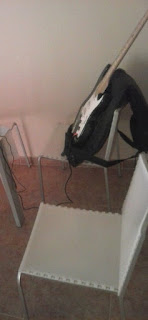Case study: transportation
lease ignore the un-lean cables hanging on the left side of the screen, and focus on the guitar on the chair. Yeah, that's right, a chair. After some experimentation, this has proven to be the best way so far to get and drop the guitar easily.
The empty chair in front is the one I use to sit, and in front of it is my computer with the daw fired up. If every time I want to do something new with the guitar I had to go through the struggle of lifting it from the floor, it would mean endless experiences of the waste of transportation, in the form of struggle on my back and shoulders, and a lot of resistance adding up in a nasty, never declared of feeling of "oh god, not again, I have to grab the guitar again". At some point it can make the difference between "OK, it is what it is, let's move on", and "let's record one more take for good measure", therefore having an impact on final quality.
That up-down lifting movement that I had to do maybe a thousand times a year, was in itself pure waste, even if it wasn't aggravated for worse by Newton's ruthless laws: going back to the definition of value, I'm pretty sure nobody who listens to my tune will be interested in how many miles the guitar had to travel to produce its notes. By putting the guitar at the same level as us, we're reducing transportation to a horizontal distance, and keeping it close to us to reduce waste as much as we can. The only moment when value is created is when the musician is generating notes, or the sound engineer is enhancing the sound. In this case, with both persons being the same, it's wise to ease the transitions.
There's one more enhancement in the picture: as the chair was slippery, I converted my guitar cover in a stand. A common premise in Lean is "use your head instead of your wallet", and I didn't have a proper guitar stand; this counts as serendipitous innovation, something I just found along the way of solving a different problem, and I like the DIY'ish feeling of the thing, that I can reproduce anywhere.
One more improvement associated to guitar transportation, not in the picture, was creating a standard for guitar-to-daw and daw-to-guitar transitions. It was very simple: short after recording with the guitar, you tend to move your attention to the computer, and if the guitar just remains on your lap, forgotten, you can be uncomfortable soon, creating fatigue and an unnecessary health hazard. So the situations I've distinguished and how I deal with them are:
1) Ended using the guitar and it's time for production work -> The guitar has no deal being in my lap, so move it back to its chair immediately (or as close to immediately as possible; obviously, if you've finished recording a track, you first want to press space to stop the recording process, that kind of tiny stuff).
2) Not ended using the guitar but have something to solve that will take a while -> It is not worth to leave the guitar if I have to pick it again soon. In this case, I slip the guitar 90º so that it rests on my legs. The relief of tension is great; if you don't do so, you are doing 2 things at the same time, and without noticing: the daw work you're engaged with, and keeping your guitar in balance. This is the standard that has benefited me the most.
3) Ready to rumble again -> Well then, quick checking of what went wrong or can do better as a performer in the next track, minimum movements required to record a new track, and let's go again!
(The guitar in the picture, btw, is called Sinforosa. I like to give a name to all my guitars, like B.B. King used to :) )

